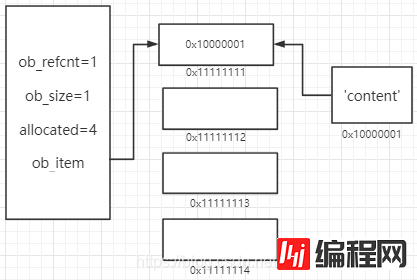Python 官方文档:入门教程 => 点击学习
目录一、列表结构体二、创建列表三、添加元素四、移除元素五、清空六、销毁一、列表结构体 创建列表C语言底层的结构体 lists = [] list.append('name') list.append('age')
创建列表C语言底层的结构体
lists = []
list.append('name')
list.append('age')
list.append('grade')
typedef struct{
struct _object *_ob_next;
struct _object *_ob_prev; // python内部将对象放在链表进行内存管理
Py_ssize_t ob_refcnt; // 引用计数器,就是多少变量用了它
PyObject **ob_item; // 指针的指针,存列表的元素
Py_ssize_t ob_size; // 已有元素个数
Py_ssize_t allocated; // 列表容量,可容纳个数
} PyListObject;
c源码来自 listobject.c
name_list = [ ]
PyObject *
PyList_New(Py_ssize_t size)
{
PyListObject *op;
size_t nbytes;
#ifdef SHOW_ALLOC_COUNT
static int initialized = 0;
if (!initialized) {
Py_AtExit(show_alloc);
initialized = 1;
}
#endif
// 缓存机制
if (size < 0) {
PyErr_BadInternalCall();
return NULL;
}
if ((size_t)size > PY_SIZE_MAX / sizeof(PyObject *))
return PyErr_NoMemory();
nbytes = size * sizeof(PyObject *);
if (numfree) {
numfree--;
op = free_list[numfree];
_Py_NewReference((PyObject *)op);
#ifdef SHOW_ALLOC_COUNT
count_reuse++;
#endif
} else {
op = PyObject_GC_New(PyListObject, &PyList_Type);
if (op == NULL)
return NULL;Py
#ifdef SHOW_ALLOC_COUNT
count_alloc++;
#endif
}
if (size <= 0)
op->ob_item = NULL;
else {
op->ob_item = (PyObject **) PyMem_MALLOC(nbytes);
if (op->ob_item == NULL) {
Py_DECREF(op);
return PyErr_NoMemory();
}
memset(op->ob_item, 0, nbytes);
}
Py_SIZE(op) = size; // 元素个数
op->allocated = size; // 容量
_PyObject_GC_TRACK(op); //放到双向链表进行维护
return (PyObject *) op; //返回列表的指针
}
list中插入一个元素时,扩容连续的内存地址(容量),在内存创建需要插入的内容p,将地址*p放入list的空间中,所以,PyListObject的ob_item是指针的指针

扩容的曲线一般就是0,4,8,16,24…
// 添加元素
static int
app1(PyListObject *self, PyObject *v)
{
// 获取实际元素个数
Py_ssize_t n = PyList_GET_SIZE(self);
assert (v != NULL);
if (n == PY_SSIZE_T_MAX) {
PyErr_SetString(PyExc_OverflowError,
"cannot add more objects to list");
return -1;
}
// 计算当前容量和内部元素个数
// 直接添加元素/扩容添加
if (list_resize(self, n+1) == -1)
return -1;
// 将元素添加到ob_item,v
Py_INCREF(v);
PyList_SET_ITEM(self, n, v);
return 0;
}
// 扩容机制
// newsize: 已存在元素个数+1
static int
list_resize(PyListObject *self, Py_ssize_t newsize)
{
PyObject **items;
size_t new_allocated;
Py_ssize_t allocated = self->allocated; // 当前的容量
// 1,容量大于个数
// 2,个数大于容量的一半(容量足够且没有内存浪费)
if (allocated >= newsize && newsize >= (allocated >> 1)) {
assert(self->ob_item != NULL || newsize == 0);
Py_SIZE(self) = newsize;
return 0;
}
// 扩容机制的算法
new_allocated = (newsize >> 3) + (newsize < 9 ? 3 : 6);
if (new_allocated > PY_SIZE_MAX - newsize) {
PyErr_NoMemory();
return -1;
} else {
new_allocated += newsize;
}
if (newsize == 0)
new_allocated = 0;
// 扩容/缩容(涉及原来元素的迁移)
items = self->ob_item;
if (new_allocated <= (PY_SIZE_MAX / sizeof(PyObject *)))
PyMem_RESIZE(items, PyObject *, new_allocated);
else
items = NULL;
if (items == NULL) {
PyErr_NoMemory();
return -1;
}
// 赋值,更新个数和容量
self->ob_item = items;
Py_SIZE(self) = newsize;
self->allocated = new_allocated;
return 0;
}
list.pop()
删除最后一个元素只需要修改size,不需要清除数据,下次append可以直接覆盖这个位置
指定索引位置移除后,向前补位
static PyObject *
listpop(PyListObject *self, PyObject *args)
{
Py_ssize_t i = -1;
PyObject *v;
int status;
if (!PyArg_ParseTuple(args, "|n:pop", &i))
return NULL;
if (Py_SIZE(self) == 0) {
PyErr_SetString(PyExc_IndexError, "pop from empty list");
return NULL;
}
if (i < 0)
i += Py_SIZE(self);
if (i < 0 || i >= Py_SIZE(self)) {
PyErr_SetString(PyExc_IndexError, "pop index out of range");
return NULL;
}
v = self->ob_item[i];
// 删除最后一个,仅改变size
if (i == Py_SIZE(self) - 1) {
status = list_resize(self, Py_SIZE(self) - 1);
assert(status >= 0);
return v;
}
Py_INCREF(v);
// 不是最后一个,需要移动数据位置
status = list_ass_slice(self, i, i+1, (PyObject *)NULL);
assert(status >= 0);
(void) status;
return v;
}
list.clear()
static int
list_clear(PyListObject *a)
{
Py_ssize_t i;
PyObject **item = a->ob_item;
if (item != NULL) {
i = Py_SIZE(a);
// 各个元素设置为空
Py_SIZE(a) = 0;
a->ob_item = NULL;
a->allocated = 0;
// 引用计数器-1
while (--i >= 0) {
Py_XDECREF(item[i]);
}
PyMem_FREE(item);
}
return 0;
}
del list
销毁列表对象的操作
将列表的引用计数-1
引用计数>0,还有应用的话不做操作
引用计数=0,没人使用
static void
list_dealloc(PyListObject *op)
{
Py_ssize_t i;
// 判断引用计数是否为0
PyObject_GC_UnTrack(op);
Py_TRASHCAN_SAFE_BEGIN(op)
if (op->ob_item != NULL) {
i = Py_SIZE(op);
while (--i >= 0) {
Py_XDECREF(op->ob_item[i]);
}
PyMem_FREE(op->ob_item);
}
// free_list没有80个的话缓存这个list
if (numfree < PyList_MAXFREELIST && PyList_CheckExact(op))
free_list[numfree++] = op;
else
Py_TYPE(op)->tp_free((PyObject *)op);
Py_TRASHCAN_SAFE_END(op)
}
就是说创建列表时,实际上不会直接开辟内存,而是先看看free_list
# 两次list的地址相同
>>> list1=[1,2,3]
>>> id(list1)
69070216L
>>> del list1
>>> list2=[0,0,0]
>>> id(list2)
69303304L
>>> 到此这篇关于Python源码解析之List的文章就介绍到这了,更多相关Python List内容请搜索编程网以前的文章或继续浏览下面的相关文章希望大家以后多多支持编程网!
--结束END--
本文标题: Python源码解析之List
本文链接: https://lsjlt.com/news/10715.html(转载时请注明来源链接)
有问题或投稿请发送至: 邮箱/279061341@qq.com QQ/279061341
2024-03-01
2024-03-01
2024-03-01
2024-02-29
2024-02-29
2024-02-29
2024-02-29
2024-02-29
2024-02-29
2024-02-29
回答
回答
回答
回答
回答
回答
回答
回答
回答
回答
0